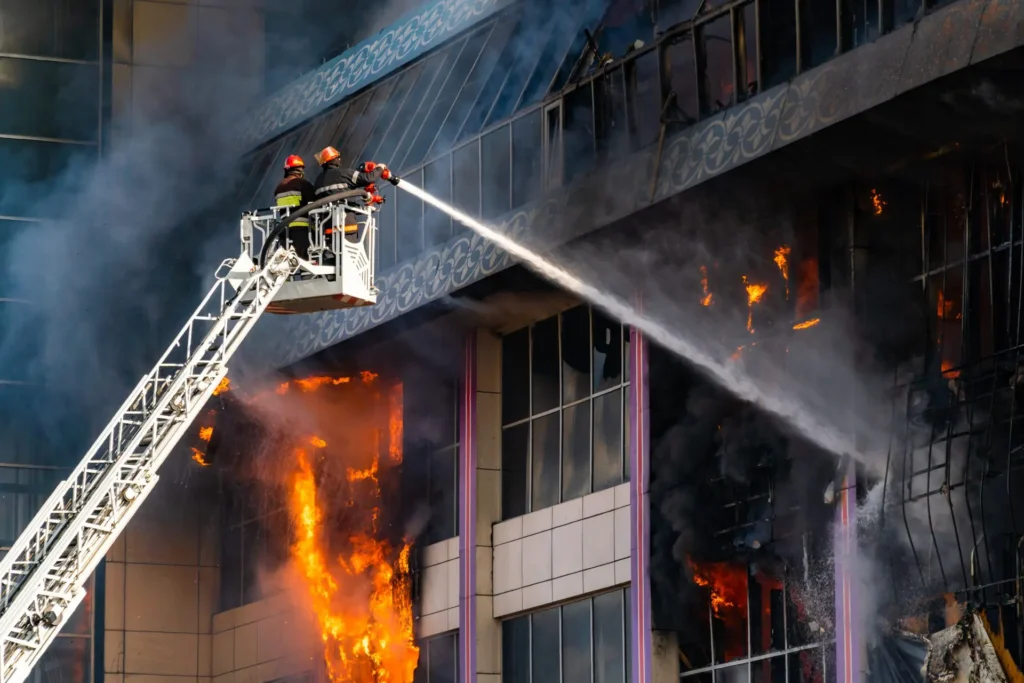Understanding Insurance Rate Increases: Insights from an Insurance Dispute Lawyer
As climate change continues to intensify, the effects are being felt across various sectors, including business owners with property. Texas, with its increasing frequency of hurricanes and hailstorms, is particularly vulnerable. For commercial building owners, this means a significant rise in insurance premiums. An insurance dispute lawyer from Stormlex Law Group can help you understand the connection between these environmental changes and your insurance rates.
With the evolving climate, commercial property owners in Texas face unique challenges, including more frequent insurance disputes as companies adjust their policies and rates.
What You Will Learn:
- The Impact of Climate Change on Building Structures
- Key Sections of Your Commercial Insurance Policy to Review
- How Insurance Companies Respond to Increased Risks
- How to Mitigate Insurance Costs During Ever-changing Weather
- Preparing for Future Insurance Challenges
How Climate Change Affects Commercial Property Insurance Rates in Texas
Climate change is having a noticeable impact on commercial property insurance rates across San Antonio, Austin, Dallas and other cities in Texas. As severe weather events like hurricanes, hailstorms, and flooding become more common, insurance companies are adjusting their rates and policies. This shift directly affects how much you, as a business owner with property, pay for insurance.
It’s important to understand why these rates are increasing and what you can do about it. By staying informed, you can make smarter decisions about your property’s insurance and potentially avoid costly surprises. Whether you’re dealing with hurricanes along the Gulf Coast or hailstorms in central Texas, the risks are real, and so are the financial implications.
The Impact of Climate Change on Building Structures
Climate change also affects the structural integrity of your buildings. As temperatures rise, materials like concrete and asphalt have the potential to expand and contract, leading to cracks and weakening foundations. Heavy rainfall and flooding, which are becoming more common, can erode the soil around buildings, compromising their stability. In areas prone to wildfires, extreme heat can cause damage to roofs and exterior walls, making structures more vulnerable to collapse. Below are some specific ways climate change impacts building structures:
- Heat Expansion: Rising temperatures can cause concrete and asphalt to expand and crack, weakening foundations and pavement.
- Soil Erosion: Increased rainfall and flooding can wash away soil around foundations, reducing a building’s stability.
- Wildfire Damage: Extreme heat from wildfires can warp or melt roofing materials, leading to potential roof collapses.
- Moisture Intrusion: More frequent and intense storms can lead to leaks and water damage, compromising the integrity of walls and ceilings. Stormlex Tip: Mold can also be found in moisture intrusion, however, it is not always covered in your policy, so be sure to review!
Understanding how climate change affects building structures helps highlight the importance of reviewing your insurance policy. Knowing the types of materials used in your building can help you assess their vulnerability to climate impacts. Some materials might be more prone to damage from heat or moisture than others. Older buildings might not have been designed to withstand modern climate extremes. Being aware of your building’s age can inform you about potential weaknesses and necessary updates. As these climate impacts become more prevalent, you must ensure your coverage adequately addresses the associated risks and requirements for your assets.
Insurance Dispute Lawyer Shares Key Sections of Your Commercial Insurance Policy to Review
Climate-related risks can affect coverage, so understanding what your policy includes is crucial. Here are key sections in your policy to pay attention to:
- Check Your Policy for “Losses insured,” “Losses not insured,” and “Covered Causes of Losses”: Ensure that your policy covers damage from severe weather events such as tornadoes, hurricanes, hailstorms, and flooding. Some policies may exclude certain types of damage, so verify that your coverage includes these risks.
- Building Code Upgrades: Check if your policy covers the costs of upgrading your building to meet current codes, which may change due to increased climate risks. Some policies offer additional coverage for these upgrades after a claim. Stormlex Tip: This is a frequent issue in Austin with new code guidelines, so be sure to check with your insurance company about coverage here.
- Flood Damage: Review the specifics of flood damage coverage. In some areas, you might need separate policies or endorsements for comprehensive protection against these risks.
- Business Interruption Coverage: Look at your business interruption coverage to see if it is within your needs. This coverage helps compensate for income lost due to property damage or operational disruptions.
- Deductibles and Limits: Pay close attention to deductibles and coverage limits. Higher deductibles or lower limits may apply to the damages you experience, affecting your out-of-pocket costs and claim payouts.
Regularly reviewing these sections and updating your policy as needed can help ensure that you’re adequately protected against the evolving risks associated with climate change. An insurance dispute lawyer from Stormlex Law Group can examine these policy details if your insurance company denies or underpays your claim.
How Insurance Companies Are Adjusting to Increased Weather Risks
Insurance companies are increasingly scrutinizing the risks posed by severe weather events as these occurrences become more frequent and intense due to climate change. This scrutiny goes beyond just raising premiums; insurers are re-evaluating and modifying their coverage options to better manage their financial exposure. It is important to remember that insurance companies are looking out for their profits, not yours. Here’s a closer look at the changes you might encounter:
- Higher Deductibles: Insurance companies may increase deductibles for policies covering severe weather damage. This means that you’ll need to pay more out of pocket before the insurance coverage kicks in. For instance, a deductible that previously covered minor damage might now be applied to more substantial claims, reflecting the increased risk insurers face.
- Exclusions for Certain Types of Damage: Some policies might now exclude coverage for specific types of damage linked to severe weather. For example, flood damage is not typically covered under a standard policy and may require a separate flood insurance policy. Similarly, damage from hail or high winds could contain cosmetic waivers or coverage limits unless additional coverage is purchased.
- More Stringent Requirements for Coverage: To qualify for full coverage, insurers may impose stricter requirements. In hurricane-prone areas, this could involve upgrading your property to meet new standards. Common requirements might include upgrades such as impact-resistant windows, or reinforcing the roof.
- Premium Adjustments Based on Risk Assessment: Insurance companies may adjust premiums based on updated risk assessments. Properties that are deemed higher risk due to their location or condition might see significant increases in their insurance premiums.
To learn more about how insurance companies might handle these situations, or to uncover general insights that insurers prefer you don’t know, watch the insurance dispute lawyer below:
How to Mitigate Insurance Costs During Ever-changing Weather
Insurers are adjusting their risk assessments and pricing to account for these evolving challenges, leading to potentially higher premiums. However, there are proactive strategies you can employ to manage and mitigate these costs.
By understanding and addressing the risks associated with extreme weather, you can take steps to reduce your insurance expenses. Implementing certain measures can not only enhance the resilience of your property but also signal to insurers that you are actively managing risks. This can lead to more favorable policy terms and potential discounts.
- Review Your Insurance Policies Regularly: Don’t just renew your policy without looking it over first. Insurance companies can change terms and rates, especially in response to climate-related risks. Make it a habit to review your policy every year to ensure it still meets your needs.
- Keep Up with Property Maintenance: Regular maintenance is one of the best ways to prevent damage and, in turn, keep your insurance costs down. Simple tasks like cleaning gutters, inspecting the roof, and checking the drainage system can go a long way. A well-maintained property is less likely to suffer severe damage, which can lead to lower premiums.
- Implement Risk Reduction Strategies: Think about ways to make your property more resilient to severe weather. This might mean upgrading to weather-resistant materials, reinforcing structures, or installing flood barriers. Some insurers offer discounts for properties that take these steps, so it’s worth looking into.
- Keep Detailed Records: Whenever you perform maintenance or repairs, keep detailed records. These documents can be invaluable if you ever need to file a claim. They show that you’ve taken care of your property, which can help avoid disputes with your insurance company.
Preparing for Future Insurance Challenges
Looking ahead, it’s clear that commercial property owners will need to be more prepared for the challenges posed by climate change. This preparation involves not just maintaining your property but also thinking strategically about how to protect it financially.
One way to do this is by investing in building upgrades that make your property more resilient. For instance, consider using sustainable and weather-resistant materials in new constructions or renovations. You might also look into green building practices that can help reduce damage from severe weather.
On the financial side, it’s wise to budget for potential premium increases and set aside funds for unexpected repairs. You might also want to explore alternative insurance options, such as parametric insurance, which pays out based on specific triggers like wind speed or rainfall. These strategies can give you more control over how you handle the financial risks associated with climate change.
Understanding how climate change affects your commercial property insurance is important for managing your property and finances. By staying informed through tips from an insurance dispute lawyer, maintaining your property, and taking proactive measures to mitigate risks, you can more effectively manage changes in the insurance landscape.
While the future may bring more challenges, being prepared will put you in a stronger position to protect your property and manage rising insurance costs. Stay on top of the trends, keep your policy up to date, and make sure your property is ready for whatever comes next.
Follow us on YouTube!
Stormlex Law Group is sharing weekly videos that break down insurance policy terms and why they matter, tips for navigating the claims process more effectively, and all things Texas insurance law-related.
If you reside in San Antonio, Dallas, Austin or another Texas city, be sure to give us a follow so that you know your property rights as a policyholder in Texas!


















